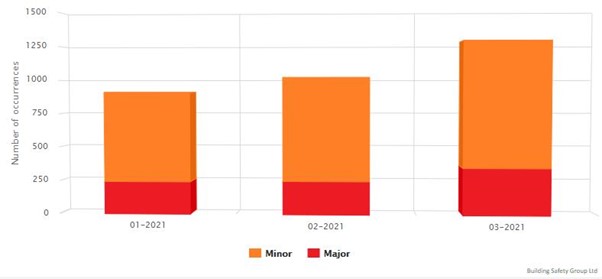 It’s safe to say that most people are aware that if you fall from a building, the likelihood is that you’re going to hurt yourself. So why is it that in the workplace the accident statistics for falling from height are still so high? In 2020 and 2021 falls from height continue to be the leading cause of death amongst workers in the UK, with the HSE revealing that 35 fatal injuries were recorded due to falls from a height in 2020, accounting for 25% of all fatal injuries over the year. In the construction industry alone, falls from height resulted in 47% of all accidents, resulting in 29 fatal injuries, 72.5% of the annual total across all industries. But why does this continue to be the leading cause of death in the UK?
It’s safe to say that most people are aware that if you fall from a building, the likelihood is that you’re going to hurt yourself. So why is it that in the workplace the accident statistics for falling from height are still so high? In 2020 and 2021 falls from height continue to be the leading cause of death amongst workers in the UK, with the HSE revealing that 35 fatal injuries were recorded due to falls from a height in 2020, accounting for 25% of all fatal injuries over the year. In the construction industry alone, falls from height resulted in 47% of all accidents, resulting in 29 fatal injuries, 72.5% of the annual total across all industries. But why does this continue to be the leading cause of death in the UK?
Severity of Injury
One reason is likely down to the fact that the type of injury sustained from falls from height is typically more severe than most others. In 2019/20, RIDDOR accounted for 16% of specified injuries being due to falls from height, with 5% of over-7-day injuries being attributed to falls from height. A comparison for this would be handling, lifting, or carrying which accounted for 5% of the total number of specified injuries, and 24% of Over-7-Day injuries. This would suggest that the types of injuries sustained from falls from height are generally of more consequence than other types of accidents.
Individual Attitudes
Another reason for these numbers could be down to the individual worker or manager’s attitude towards the protective measures in place. Because it is such an obvious hazard, complacency could come into play and lead to an increase in the number of injuries related to working at height. Research by the Building Safety Group published in April 2021 states that there was an increase in Working at height breaches of 84% in the first quarter of 2021. This resulted in over 2000 individual breaches recorded across 4300 independent site inspections between 1st January and 31st March 2021. This would suggest that the level of protection across construction sites in the UK is not sufficient and might be caused by a lack of consideration to the care of the worker’s safety by the management, or disregard for the rules from the workers themselves.
How Do I Reduce the Risk of Injury?
 However, there are many ways to reduce the risk of injury from falls from height. There are a wide variety of control measures which can be put into place by employers to ensure they are doing everything which is reasonably practicable to safeguard their employees from these potential hazards. The HSE has a variety of documents and papers which identify the hazards that working at height can present and provide suggestions to ensure that employers are working within the guidance of the Working at Height Regulations 2005. A number of the key measures have also been summarised in our ‘Working at height: Back to Basics’ blog.
However, there are many ways to reduce the risk of injury from falls from height. There are a wide variety of control measures which can be put into place by employers to ensure they are doing everything which is reasonably practicable to safeguard their employees from these potential hazards. The HSE has a variety of documents and papers which identify the hazards that working at height can present and provide suggestions to ensure that employers are working within the guidance of the Working at Height Regulations 2005. A number of the key measures have also been summarised in our ‘Working at height: Back to Basics’ blog.
Another way to improve the level of competence and awareness in the workforce is through training and working towards qualifications provided by organisations such as IPAF for the use of Mobile Elevated Work Platforms (MEWPs), and PASMA membership for the construction of mobile work towers. WA Management can provide training courses to update your workforce’s knowledge on the hazards that are present when working at height.
For this month only, you can also get 10% off WA Management’s‘Working at Height’ and ‘Risk Assessment’ online courses – just use the code ‘WorkatHeight10’ at checkout!
Written by our SHEQ Trainee, Tom Wheeler



